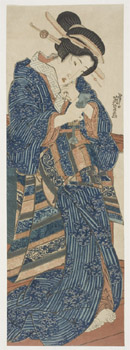 |
Keisai Eisen (1790-1848), Geisha Looking at Her Reflection in a Hand Mirror, early-mid 1830s, woodblock print, ink and color on paper, vertical oban diptych (kakemono-e); John Chandler Bancroft Collection, 1901.257 |
September 15, 2007 - March 2, 2008
Prints of famous courtesans and geisha of the pleasure quarters, which first became popular in the early 18th century, were purchased by the fashion-conscious and pleasure-seeking public of the “floating world” (ukiyo) of Edo (present-day Tokyo. Stimulating local trade these bijin-ga (pictures of beautiful women) showed beauties modeling the latest hairstyles, accessories, make-up and textile designs. The tastes of pivotal artists and popular actors as well as changes in the societal conception of femininity continued to have an impact on fashion. The artists Toyokuni I, Shunsen, Eizan, Eisen and Kunisada, featured in this exhibition, developed and spearheaded the bijin-ga tradition during the first three decades of the 19th century. The women in their prints are often posed with slightly bent backs and knees, and dressed in lavishly decorated kimono and costly hair ornaments. Brighter colors, including the imported “Berlin blue” (widely used after 1829), and the frequent use of a vertical diptych-sheet format that could be mounted onto hanging scrolls, also served to infuse their works with stylishness.
| Select Images from the Exhibition | |||

|

|

|

|

 Sign up for WAM eNews
Sign up for WAM eNews